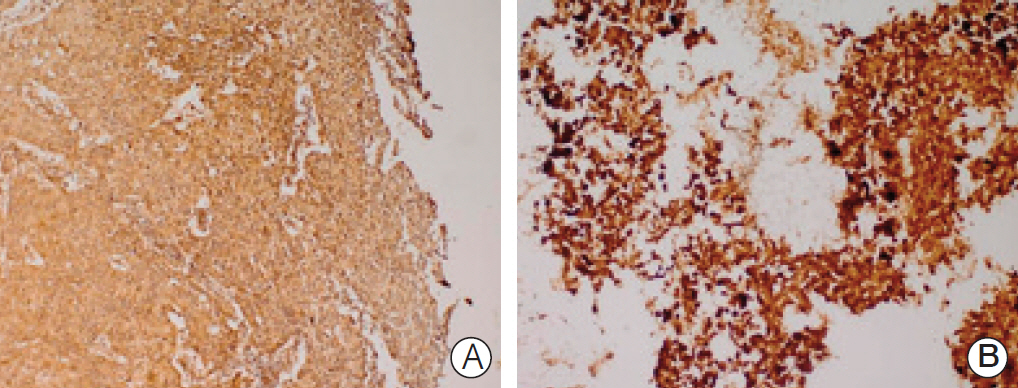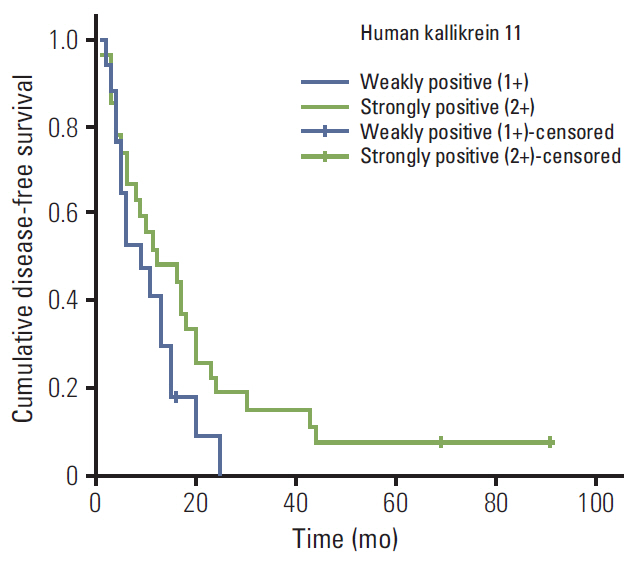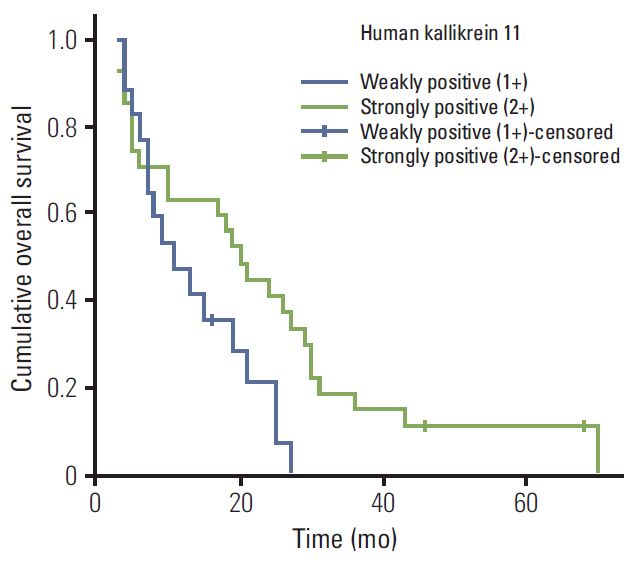Cancer Res Treat.
2016 Jan;48(1):98-105. 10.4143/crt.2014.364.
Is Human Kallikrein 11 in Non-small Cell Lung Cancer Treated Chemoradiotherapy Associated with Survival?
- Affiliations
-
- 1Department of Radiation Oncology, Kayseri Education and Research Hospital, Kayseri, Turkey. dilekunaldr@gmail.com
- 2Department of Radiation Oncology, Erciyes University Medical Faculty, Kayseri, Turkey.
- 3Department of Pathology, Kayseri Education and Research Hospital, Kayseri, Turkey.
- 4Department of Radiation Oncology, Sutcu Imam University Medical Faculty, Kahramanmaras, Turkey.
- 5Department of Medical Oncology, Kayseri Education and Research Hospital, Kayseri, Turkey.
- KMID: 2152265
- DOI: http://doi.org/10.4143/crt.2014.364
Abstract
- PURPOSE
Involvement of human kallikreins (hKs) in human cancers has been reported and several hKs are promising biomarkers of various cancers. The aim of this study was to evaluate the prognostic significance of hK11 expression in patients with non-metastatic non-small cell lung cancer (NSCLC).
MATERIALS AND METHODS
The study included 44 patients with NSCLC. hK11 expression was determined by immunohistochemical staining.
RESULTS
The estimation of disease-free and overall survival by Kaplan-Meier was 11 months and 17 months, respectively. The estimation of overall survival by Kaplan-Meier was significantly higher in patients with hK11 strongly positive (2+) than in those with hK11 weakly positive (1+) (20 months vs. 11 months, p=0.032). Although not statistically different, the estimation of disease-free survival by Kaplan-Meier was higher in patients with hK11 strongly positive (2+) than in those with hK11 weakly positive (1+) (12 months vs. 9 months, p=0.113). Multivariate Cox regression analysis showed that the overall survival rates were significantly associated with response to chemoradiotherapy and the degree of staining with hK11.
CONCLUSION
The stronger hK11 expression in NSCLC appears to be associated with better survival rates. hK11 may be a prognostic biomarker of NSCLC.
Keyword
MeSH Terms
Figure
Reference
-
References
1. Siegel R, Ward E, Brawley O, Jemal A. Cancer statistics, 2011: the impact of eliminating socioeconomic and racial disparities on premature cancer deaths. CA Cancer J Clin. 2011; 61:212–36.2. Oguz A, Unal D, Tasdemir A, Karahan S, Aykas F, Mutlu H, et al. Lack of any association between blood groups and lung cancer, independent of histology. Asian Pac J Cancer Prev. 2013; 14:453–6.
Article3. Finkelstein DM, Ettinger DS, Ruckdeschel JC. Long-term survivors in metastatic non-small-cell lung cancer: an Eastern Cooperative Oncology Group Study. J Clin Oncol. 1986; 4:702–9.
Article4. Unal D, Tasdemir A, Oguz A, Eroglu C, Cihan YB, Turak EE, et al. Is human kallikrein-11 in gastric cancer treated with surgery and adjuvant chemoradiotherapy associated with survival? Pathol Res Pract. 2013; 209:779–83.
Article5. Xu CH, Zhang Y, Yu LK. The diagnostic and prognostic value of serum human kallikrein-related peptidases 11 in non-small cell lung cancer. Tumour Biol. 2014; 35:5199–203.
Article6. Diamandis EP, Yousef GM. Human tissue kallikreins: a family of new cancer biomarkers. Clin Chem. 2002; 48:1198–205.
Article7. Planque C, Li L, Zheng Y, Soosaipillai A, Reckamp K, Chia D, et al. A multiparametric serum kallikrein panel for diagnosis of non-small cell lung carcinoma. Clin Cancer Res. 2008; 14:1355–62.8. Borgono CA, Fracchioli S, Yousef GM, Rigault de la Longrais IA, Luo LY, Soosaipillai A, et al. Favorable prognostic value of tissue human kallikrein 11 (hK11) in patients with ovarian carcinoma. Int J Cancer. 2003; 106:605–10.9. Yu X, Tang HY, Li XR, He XW, Xiang KM. Over-expression of human kallikrein 11 is associated with poor prognosis in patients with low rectal carcinoma. Med Oncol. 2010; 27:40–4.
Article10. Yousef GM, Diamandis EP. The new human tissue kallikrein gene family: structure, function, and association to disease. Endocr Rev. 2001; 22:184–204.
Article11. Diamandis EP, Borgono CA, Scorilas A, Harbeck N, Dorn J, Schmitt M. Human kallikrein 11: an indicator of favorable prognosis in ovarian cancer patients. Clin Biochem. 2004; 37:823–9.
Article12. Lowitz BB, Casciata DA. Principles of medical oncology and cancer biology [Internet]. Philadelphia, PA: Lippincott Williams & Wilkins;2000. [cited 2014 Nov 12]. Available from: http://www.justmed.eu/files/st/oncologie/Casciato,%20Lowitz%20-%20Manual%20of%20Clinical%20Oncology.pdf.




